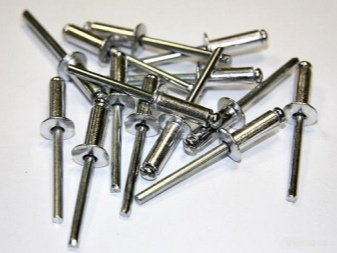Varieties and sizes of steel rivets

The types and sizes of steel rivets are extremely important for various construction and installation work. There are rivets with a semicircular head for a riveter, countersunk, driven and other models. Their size has a lot to do with how a particular version can be used.


Description
Mass-produced steel rivets are a characteristic feature of many modern jobs in various industries. It is worth considering that the riveting method is used very widely, and not only when working with metal products. Riveted joints are also used in clothing and accessories. When working with metal, steel rivets are much more practical than conventional screw connections.
Nuts and bolts are more expensive and cannot be worked with as quickly.


Species overview
Products with a semicircular head are widespread. This item meets the requirements of GOST 10299-80. The cross-section of the rod is from 0.1 to 3.6 cm. A steel rivet for a countersunk hammer must comply with GOST 10300-80. For products with a flat head, standard 10303-80 applies. Finally, for semi-hollow samples, GOST 12641-80 is used.
For the manufacture of such devices, steel of the following types is used:
- 10kp;
- 15kp;
- St2;
- St3.


All metal shank rivets have excellent load carrying capacity. However, it is rather difficult to establish them. The semi-hollow type is formed in such a way that the section of the rod near the insert head is partially empty. Finally, the hollow product is easy to rivet. The flip side of this advantage is insufficient connection reliability. Semicircular heads can have different heights. Their use is considered the optimal solution from the point of view of the reliability and stability of the seam being formed.
In aggressive environments, rivets with a cylindrical or cone-shaped head are used. Countersunk and semi-secret types are needed if you want to exclude the formation of a protrusion above the surface. Such constructions are used only in cases where there is no worthy alternative to them. A universal type of fastener for a riveter in shape resembles the contours of a mushroom. A separate category is embedded, exhaust, traction and detachable products. Such hardware consists of two main parts. There is no need to hold them on the other side of the seam. This circumstance is very attractive when creating fences and forming roofing.


Sometimes there are so-called threaded rivets. They are used when it is necessary to connect parts with especially thin walls (no more than 0.03 cm). Inside there is a special thread, and outside there is a vertical notch that blocks rotation around its axis. Driven rivets are usually made from:
- brass;
- aluminum;
- copper (and all such products are calculated for hammering and do not require a riveter).
Sometimes a zinc coating is used to increase corrosion resistance. Both "cold" and "hot" galvanizing shows itself well. After such processing, not only performance is improved, but also the visual perception of products. Important: it is necessary to take into account the formation of galvanic pairs and electrochemical reactions between them. The copper-steel bond results in accelerated destruction of the product.


Dimensions (edit)
A typical steel rivet can be 2 to 8 mm in diameter. The length ranges from 6 to 65 mm.In the assortment of large manufacturers, hardware products are most often used with a cross section:
- 3;
- 3,2;
- 4;
- 4,8;
- 5;
- 6;
- 6.4 mm.
The dimensions of the riveted fastener affect the thickness of the parts and surfaces to be joined. Typical ratios:
- 3.0x6 - for thickness from 1.5 to 3.5 mm;
- 3.0x16 - for a layer from 11 to 13 mm;
- 3.0x20 - for a layer from 15 to 17 mm;
- 3.2x14 - for thickness from 9 to 11 mm;
- 4.0x28 - for products from 21.5 to 24 mm.


How to use?
It is not too difficult to use rivets - for cylindrical products, you can even do without a special tool, an ordinary hammer is enough. You can work very successfully even in the "field" conditions, not to mention a full-fledged workshop. The largest steel rivets are used in the assembly of bridges and overpasses. Smaller products are in demand in mechanical engineering and instrument making. Important: riveted joints are not tight enough by default, and it is possible to seal them properly only when using sealants and special brands of rubber.
A hole is usually drilled beforehand. If a countersunk rivet is used, countersink is recommended. The process in the case of a blind rivet is something like this:
- insert a rivet;
- pull together the necessary details;
- form a closing head (using a tool);
- check the readiness of the connection, if necessary, clean it.
If you have a decent tool, the work goes very quickly. In private practice, manual riveters are used. The job takes a matter of seconds. Drilling takes much longer. The holes in the profiled sheet are painted to prevent corrosion.


For information on how to make a steel rivet with your own hands, see the next video.













The comment was sent successfully.